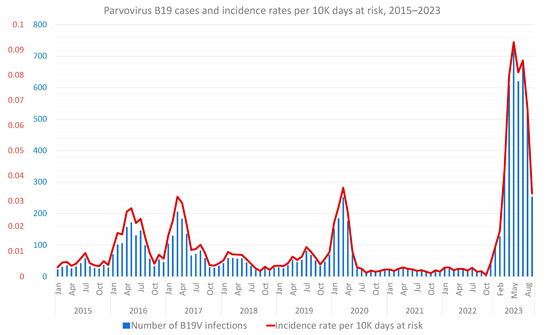Published: 16 November 2023
Viruses 2023, 15(11), 2261; https://doi.org/10.3390/v15112261
Patalon, T.; Saciuk, Y.; Trotzky, D.; Pachys, G.; Ben-Tov, A.
Abstract
Human parvovirus B19 (B19V) has a wide clinical spectrum, ranging from an asymptomatic infection to a life threatening one. During pregnancy, it can lead to fetal loss and hydrops fetalis. This retrospective study examined the incidence rates of B19V in Israel, analyzing anonymized electronic medical records of 2.7 million individuals between January 2015 and September 2023. A generalized linear model with a Poisson distribution was fit to the data, adjusting for potential confounders. A marked increase in B19V was observed in 2023, with an adjusted incidence rate ratio (IRR) of 6.6 (95% CI 6.33–6.89) when comparing 2023 to previous years. When specifically comparing 2023 to COVID-19 years (2020–2022), adjusted IRR climbs to 9.21 (8.66–9.80). Moreover, in 2023, previously existing seasonality has largely disappeared. High SES characterized most infected individuals with a marked discrepancy in social sectors; the Arab population was significantly less likely to be found B19V positive, even when adjusting for SES. Most infections occurred in school-aged children (6–11 years old). Pregnant women experienced the most significant rise in B19V, with an adjusted IRR of 11.47 (9.44–13.97) in 2023 compared to previous years; most cases were diagnosed in the first trimester. This study demonstrates that Israel is currently experiencing the largest and longest reported outbreak of B19V to date. Policymakers should consider setting screening policies in place, at least for populations at risk, while specifically studying and potentially targeting low socioeconomic populations and specific social sectors to avoid health inequalities.
Viruses 2023, 15(11), 2261; https://doi.org/10.3390/v15112261
Patalon, T.; Saciuk, Y.; Trotzky, D.; Pachys, G.; Ben-Tov, A.
Abstract
Human parvovirus B19 (B19V) has a wide clinical spectrum, ranging from an asymptomatic infection to a life threatening one. During pregnancy, it can lead to fetal loss and hydrops fetalis. This retrospective study examined the incidence rates of B19V in Israel, analyzing anonymized electronic medical records of 2.7 million individuals between January 2015 and September 2023. A generalized linear model with a Poisson distribution was fit to the data, adjusting for potential confounders. A marked increase in B19V was observed in 2023, with an adjusted incidence rate ratio (IRR) of 6.6 (95% CI 6.33–6.89) when comparing 2023 to previous years. When specifically comparing 2023 to COVID-19 years (2020–2022), adjusted IRR climbs to 9.21 (8.66–9.80). Moreover, in 2023, previously existing seasonality has largely disappeared. High SES characterized most infected individuals with a marked discrepancy in social sectors; the Arab population was significantly less likely to be found B19V positive, even when adjusting for SES. Most infections occurred in school-aged children (6–11 years old). Pregnant women experienced the most significant rise in B19V, with an adjusted IRR of 11.47 (9.44–13.97) in 2023 compared to previous years; most cases were diagnosed in the first trimester. This study demonstrates that Israel is currently experiencing the largest and longest reported outbreak of B19V to date. Policymakers should consider setting screening policies in place, at least for populations at risk, while specifically studying and potentially targeting low socioeconomic populations and specific social sectors to avoid health inequalities.
